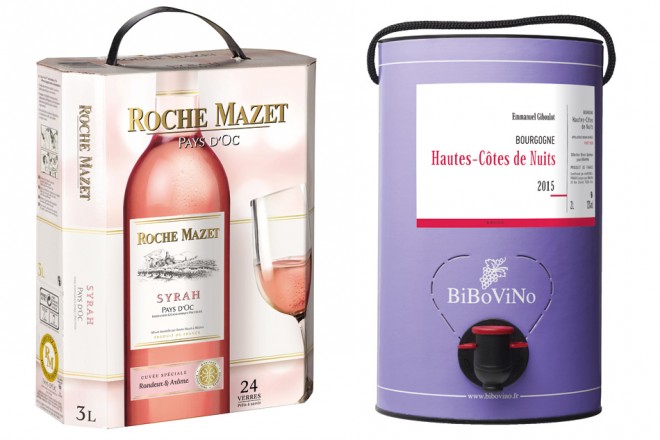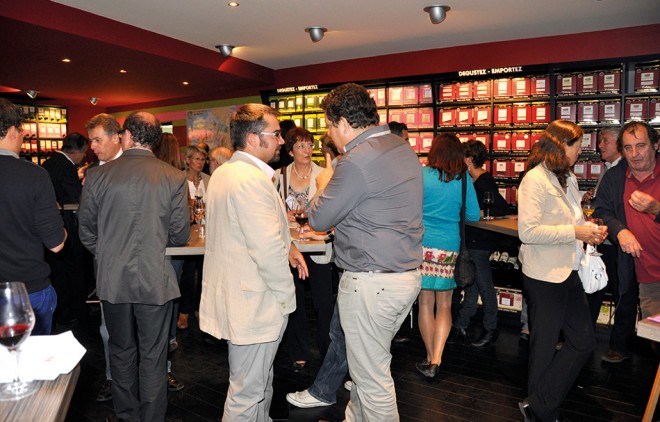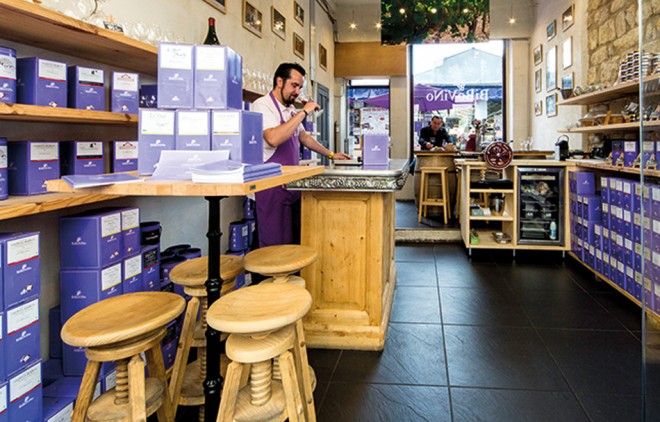In the early 80s who would have imagined the tremendous development of box wine and its success 30 years later? Non-existent in the early 2000s the Bag in Box format has been continuing an uninterrupted growth until now, the consumers getting increasingly seduced by this ‘strange’ container: useful, economical, unbreakable, eco-friendly and ever more qualitative.

General name of the Bag in Box often (wrongly) called ‘cubi’ for Cubitainer [plastic cubic container], the bag-in-a-box packaging is a container of various sizes made of a corrugated fiberboard box and an airtight supple pouch used for the transportation and storage of liquids. It has been used for the first time for wine in Australia in the 60s, and in 1973 a French packaging manufacturer launched a product under the name of Bag-in-Box* (now property of Smurfit-Kappa). The Bag in Box or BiB soon became the common name of box wine and faces since the early 2000s an uninterrupted growth.
Barely present 15 years ago, representing 21% of the volume of wines sold in France in 2007 and 27% in 2010, the Bag in Box (existing in three sizes: 3, 5 and 10 liters) totaled 366 million liters in 2015, i.e. 38% of the volumes, and the share keeps growing. Already very present in the mass distribution with nearly 40% of the sales and a 1 billion euros turnover, the BiB should represent 50% of the volumes in this sales channel by 2020 according to Euromonitor. A development in which rosé plays a major role as sales in this packaging have tripled between 2007 and 2015, but that now concerns all kinds of wines. And although the share of AOPs in box wines has slightly reduced in this same period decreasing from 29 to 24% in favour of wines without GIs, the Bag in Box now is present in all the greatest French appellations, as much with famous brands as with estates.
An underlying trend in France but also in other consuming countries like Northern Europe where the consumption of box wines represents nearly half of the wines sold, or Belgium, USA or United Kingdom.

And the BiBs keep on moving into the wine areas, are revealed in the restaurants or find their place in the kitchen of consumers who are ever more convinced by the advantages of box wine.
When Jean-Paul and Sophie Lafage, who created the first range of box wines “Collection Verre après Verre”, started in the early 90s they were almost the only ones to believe in it. Jean-Paul is the one who managed to convince the Bordeaux wine syndicate to allow the use of BiBs in the AOCs of Bordeaux. And Alsace still refuses! In 2016, some consider it as one of the major keys of development of the wine market; Franck Crouzet, Castel communications manager, even says it is “the most dynamic driving force of the domestic (French) market”.
A success very probably due to the specific qualities of this container now recognized by the consumers and professionals, restaurants, sommeliers or wine boutiques: the BiB is convenient (handle, tap, excellent preservation after opening), unbreakable, aesthetic (pictures, labels, graphics) and eco-friendly with a carbon balance 6 times lower for a 3-liter BiB than a 0.75-cl bottle, and 8 times less for a 5-liter BiB. Specificities dear to all the greatest operators and Bag in Box specialists to turn this container into a little concentrate of innovative technology, whether for the different elements of the container (pouch or tap) or for the bagging, or the manufacturing of the box with a studied design.
For example Castel equipped their site of Saint Priest in the Rhone Valley in 2014, then Béziers in Languedoc in 2015, with new bagging lines. Jean-Paul Lafage created the first truck fitted with an entirely automatic bagging unit for ‘Collection Verre après Verre’ whereas BiBoViNo, a network of wine boutiques created in 2013 with a range of ‘gorgeous BiBs for exceptional wine growers wines’, entrust a bottling specialists in Burgundy with their wines in order to control the whole process.
But beyond the packaging, it is the quality upgrading of the box wines at especially attractive prices that explains such a craze. BiBoViNo will have 35 shops in France and abroad by the end of 2016, offering 40 to 50 references carefully selected in all the French appellations in the three colours. One of the founders and chaiman Frantz Roesch cites the example of the Moulin à Vent 2014 by Jean-Paul Brun or the Hautes-Côtes de Nuits 2015 by Emmanuel Giboulot in his festive selection. His entry level 3-l BiBs are priced €20-22 whereas he proposes a Crozes-Hermitage at €42 (retail price) and mentions his top-end wines are the bestsellers.
Castel propose all their flagship brands and newest products in Bag in Boxes in differents colours and range levels, including the Castel chateaus whose sales increased by 25% in 2015. Supermarket chain U says of its range of box wines ‘Club des Vins & Terroirs’ it is a “label of passion and pleasure for premium quality box wines”.
Another economic asset of box wines is the increase of the on-trade turnover with the development of the wine-by-the-glass service. To Franck Roesch, “it is the zero cost solution to waste on a wine-by-the-glass list”, and to Jean-Paul Lafage “20 BiBs are enough to propose 20 different wines to your customers without the preservation problem and with an excellent multiplying factor”, and yet only 40% of the restaurants use Bag in Boxes for such service.

Beside the practical and quality assets of the Bag in Boxes that explain their success, they also follow the trend of the new consumption habits: a simple and unabashed purchase, outside standard codes; consuming by the glass alone or with a group, off or on trade, over time (6 to 8 weeks); space saving and eco-friendly behaviour. Not to forget how easy it becomes to pair dishes as a cellar is available at any time.
And yet only 23.7% of the French bought box wine in 2015 (vs a 86.5% penetration rate for the wine in general), and some consumers keep on mistaking it for the cubitainer that has not its technical and preservation qualities. And what about the producers still reluctant to bagging their wines or some French wine syndicates or wine producing countries?
Nadine Franjus-Adenis, enologist and blogger (blog-du-bib.fr), does not hesitate in saying “that to assess the quality of an estate, first taste their entry level wine. Their box wine often is a good example. If the box wines is good, the whole range is.”
Communication on the image of the Bag in Box, spotlighting in the wine areas in the supermarkets, increasing tasting opportunities for consumers and professionals and development of the export are some of the issues the operators of the sector are working on to confirm these good performances and better attract the lovers of (good) wine.
In 2016 Vitisphère launched a unique tasting experience focused on BiBs, the Open Wine Box-Tour with the creation of spaces dedicated to these containers during the greatest trade fairs like Vinisud or Salon des Vins de Loire. “Over 100 exhibitors and producers answered positively … a real success! These new free tasting areas have found their place, their originality but also their legitimacy as a new type of product and stood out on these fairs, especially among the buyers!”, Laurent Causin, Vitisphère market manager, states with enthusiasm.
• sales of BiBs in supermakets (France) :
• Sales breakdown of box wine in hyper and supermarkets*
by category :
- IGP varietal: 35,5 %
- AOP : 24 %
- Standard IGP: 18,6 %
- Wines without GI: 14,3 %
- Foreign wines: 18,6 %
Par couleur :
- Red : 48,4 %
- Rosé : 40,9 %
- White : 10,7 %
* over a year (April 2015 – April 2016)
Sources : CIVB / IRI – Euromonitor – Kantar – Vitisphère – Rayons Boissons – Smurfit Kappa